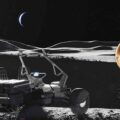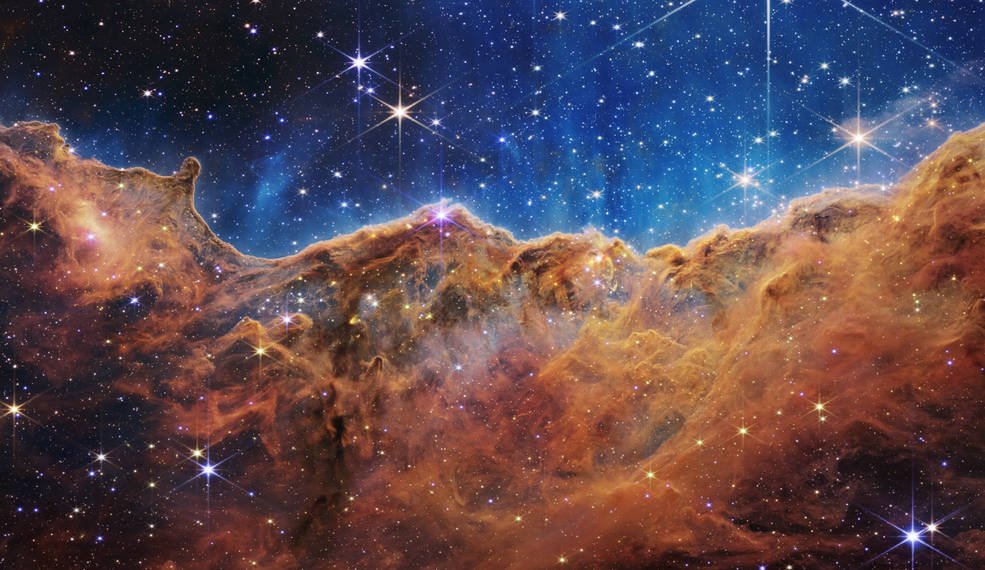

Welcome to this week’s installment of The Intelligence Brief… following Tuesday’s historic release by NASA of the first images captured by its groundbreaking James Webb Space Telescope, this week in our analysis we’ll be 1) recapping NASA’s big reveal party, 2) looking at what Webb’s Deep Field imagery is able to tell us about remote corners of the universe, and 3) why the work Webb will achieve in the years ahead is so significant.
Quote of the Week
“The cosmos is within us. We are made of star stuff. We are a way for the universe to know itself.”
– Carl Sagan
Before we dive into things this week, a few of the stories we’ve been covering in recent days at The Debrief include a recent study that further supports that altered states of consciousness are the key to psychedelic therapy, after finding no positive impact from psilocybin microdosing. Meanwhile, China has published a new proposal for an orbiter spacecraft that it says is capable of traveling to planet Neptune by 2040. Also, researchers say they have successfully used everyday bacteria to create the key ingredient for rocket fuel… where could it be used to take us in the years ahead?
While that remains to be seen, right now you can head on over and see the latest videos from The Debrief on our official YouTube channel, where you’ll find recent episodes of Rebelliously Curious with our own Chrissy Newton, and much more. And as always, you’ll find a complete roundup of all our latest articles at the conclusion of this newsletter.
And with all that behind us, we now look ahead at the future of the James Webb Space Telescope and its promising capabilities… but first, a quick look at what was happening Tuesday in Greenbelt, Maryland, during NASA’s big reveal party.
Webb’s First Images: NASA Hosts a Historic Reveal
Earlier this week, the world was treated to the first highly anticipated images produced by NASA’s James Webb Space Telescope, a project decades in the making that has now offered us a glimpse at distant features of our universe in unprecedented detail.
The series of images were unveiled Tuesday morning in a live online event broadcast by the American space agency from NASA’s Goddard Space Flight Center in Greenbelt, Maryland, featuring a who’s who of current NASA scientists, project leaders, and other personnel and partners from around the world.
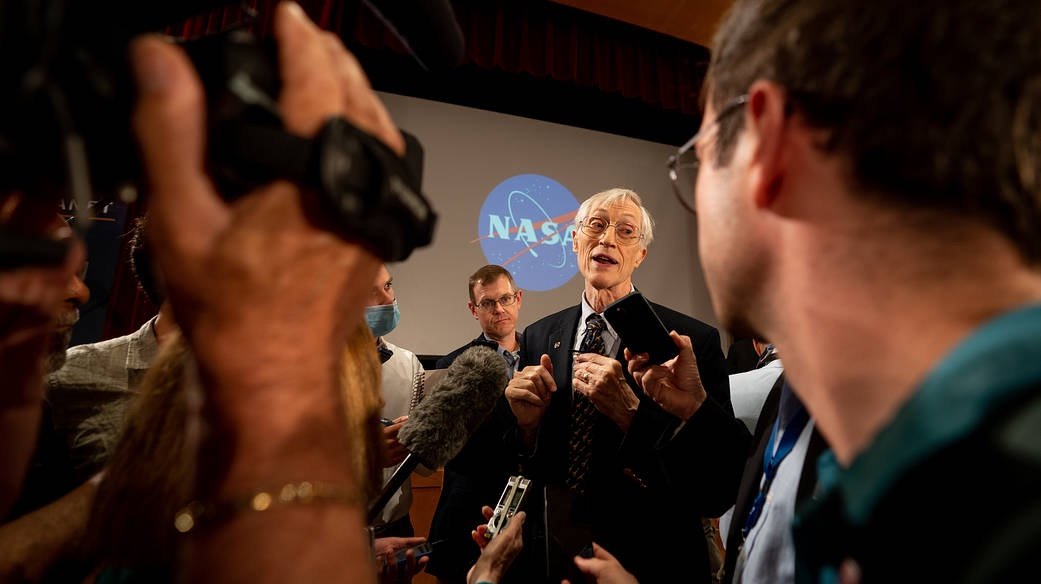

The event followed a surprise unveiling of one of the images by President Joe Biden at the White House Monday afternoon, and the images were also made available for download on NASA’s website.
“NASA’s James Webb Space Telescope has delivered the deepest and sharpest infrared image of the distant universe so far,” a NASA statement read, describing the first in the incredible new set of new images—a Deep Field galaxy cluster called SMACS 0723—as “teeming with thousands of galaxies – including the faintest objects ever observed in the infrared.”
Apart from the raw beauty of the cosmos the new images give us, they are also providing scientists a wealth of new information that is already reshaping the way we think about our universe.
Webb’s Deep Field Imagery Reveals Finer Details of Our Universe Than Ever Before
Approximately the size of a grain of sand held at arm’s length, Webb’s inaugural Deep Field image revealed at the White House on Monday is already now among the clearest images humans have ever obtained of distant galaxies.
However, one of the unique features of the first image produced by Webb has to do with the underlying physics of the objects in the image, and what they reveal to astronomers for the first time. The combined mass represented by the galaxy cluster in the image serves as a gravitational lens, that actually magnifies even more distant galaxies.
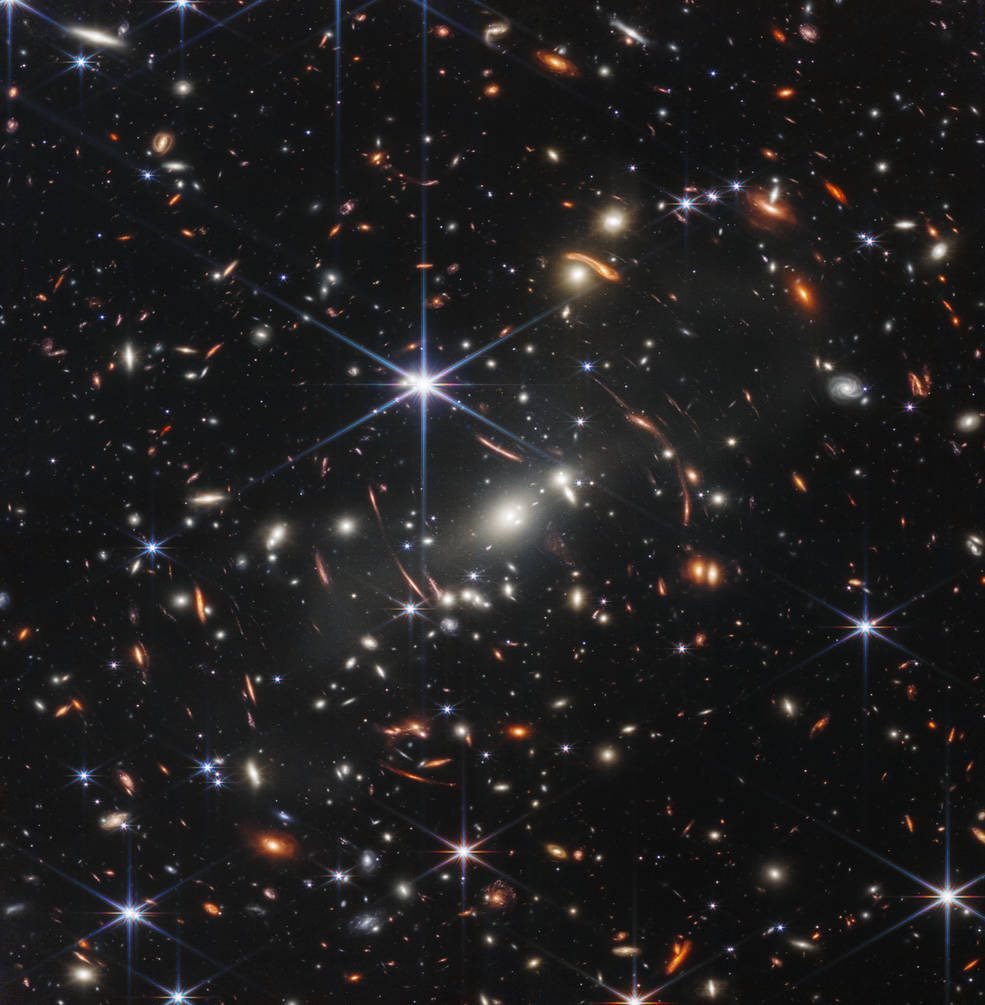

A unique property of space has to do with how matter between a far distant light source and an observer is capable of bending light from that source as it makes its way to our eyes. Known as gravitational lensing, this unique phenomenon was one of the many products of Albert Einstein’s revolutionary theory of general relativity.
“The combined mass of this galaxy cluster acts as a gravitational lens, magnifying more distant galaxies, including some seen when the universe was less than a billion years old,” read a NASA statement accompanying the release of Webb’s first image.
Like many of the most striking images in modern astronomy, the first Webb image, captured by the telescope’s Near-Infrared Camera (NIRCam), is actually a composite of several different images all taken at different spectral wavelengths. The constituent imagery was collected over more than 12 hours, absorbing wavelengths of light well beyond even the deepest fields capable of Webb’s predecessor, the Hubble Space Telescope.
Significantly, images like these are not just showing our universe in unprecedented detail, but the incredible field imagery Webb’s Mid-Infrared Instrument (MIRI) is gathering also depicts how it looked 4.6 billion years ago. Looking at the new Webb images is quite literally like looking back into time at an earlier phase of the galactic formation in our universe.
“We’re seeing [galaxies] as they looked back in time,” said Jane Rigby, Webb Operations Scientist, during Tuesday’s online event. Rigby said the first image captured by Webb is “teeming with galaxies,” adding that it provides “a sharpness and clarity we never had.”
However, the clarity and unique perspectives on galactic formation aren’t all the new Webb images provide for us, as responses to the newly released images have conveyed over the last several days.
the James Webb Space Telescope: Helping Redefine Tomorrow’s Reality
The responses to Webb’s first images were many, as expected, and all seemed to express the collective excitement over what NASA’s most advanced observatory yet will be able to achieve in the coming years.
“Today, simply, is for the dazzle,” wrote Time columnist Jeffery Kluger of the Webb images release on Tuesday. “The universe can stun with its scope and its beauty. Webb, more than any observatory before it, is pulling the curtain on all of that back.”
“The first images from Webb represent only a sliver of the science it will make possible,” wrote Alexandra Witze in Nature, who emphasized the promise of forthcoming studies Webb will help facilitate, which includes everything from the study of faint distant stars and rocky exoplanets that may surround them, to nearby neighbors in our own planetary community like Jupiter and Neptune.
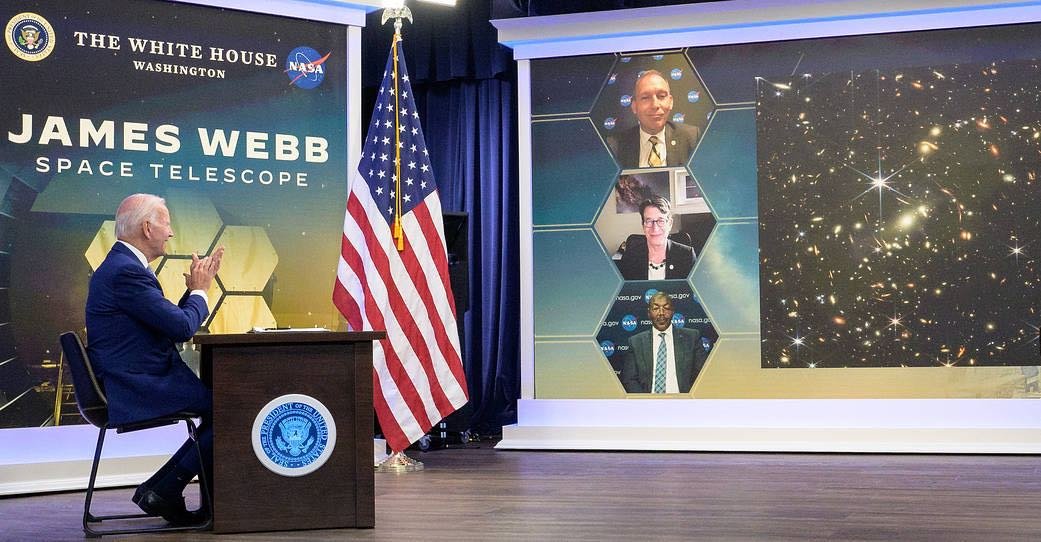

“It’s clear that Webb represents the best of NASA,” said NASA Administrator Bill Nelson during Tuesday’s online event.
“It maintains our ability to propel us forward, for science, for risk taking, for inspiration. And we don’t wanna ever stop exploring the heavens, nor stop daring to take another step forward for humanity.”
“Somewhere something incredible is waiting to be known,” Nelson said, quoting the famous words of the late astronomer Carl Sagan.
One has to stop and imagine what else Carl Sagan might have said about the incredible images of what the late astronomer once called “star stuff”, captured by Webb in new and unprecedented detail. Although in truth, there is perhaps already no better Sagan sentiment than the one quoted by Nelson on Tuesday, to which he tacked on a poignant observation of his own.
“I think those words are becoming reality,” Nelson said. Indeed, the new vision of reality that Webb’s awesome imagery will afford us in the years to come is guaranteed to take our understanding of the universe to new places, and almost certainly will help us uncover the kinds of incredible discoveries that Sagan, and many other great minds throughout the history of science, all once dreamed of.
That concludes this week’s installment of The Intelligence Brief. You can read past editions of The Intelligence Brief at our website, or if you found this installment online, don’t forget to subscribe and get future email editions from us here. Also, if you have a tip or other information you’d like to send along directly to me, you can email me at micah [@] thedebrief [dot] org, or Tweet at me @MicahHanks.


Here are the top stories we’re covering right now…
- Stunning First Images From James Webb Space Telescope Mark “Dawn of a New Era” for NASA
The first complete set of images captured by NASA’s James Webb Space Telescope, “the world’s largest and most powerful space telescope,” was just revealed by NASA.
- In Psychedelic Therapy, The “Mystical Experience” Could Be Key
A recent study further supports that altered states of consciousness are the key to psychedelic therapy, after finding no positive impact from psilocybin microdosing.
- Could China be Headed to Neptune Soon?
China has published a new proposal for an orbiter spacecraft that it says is capable of traveling to planet Neptune by 2040.
- James Webb Space Telescope First Image Unveiled in Early Preview at the White House
President Joe Biden has unveiled one of the first images captured by NASA’s James Webb Space Telescope in an early debut at the White House.
- Will Future Spacecraft Use ‘Jaws’ Bacteria to Make Rocket Fuel?
Researchers say they have successfully used everyday bacteria to create the key ingredient for rocket fuel.
- U.S. Space Force Launches Classified Payloads Aboard Satellites to Test Early Warning System
The U.S. Space Force recently launched two satellites with the help of Atlas 5 to test the new early warning weapons system.
- The Hudson Valley UFOs: How the Media Reacted to a 1980s UFO Flap
Jazz Shaw revisits an unusual series of sightings of aerial objects in upstate New York in the 1980s, known today as the Hudson Valley UFO flap.
- Sunlight and the Extinction of Gamma-Rays
Our ultimate cosmic destiny is to become dark matter. For now, let’s enjoy the light show while it lasts.
- NASA’s Launch of CAPSTONE’s CubeSat Paves the Way for Next Phase of Space Exploration
NASA recently launched CubeSat, a small satellite that will help the space agency prepare for its forthcoming Artemis missions.
- Famous Roswell UFO Incident Celebrates 75th Anniversary
75 Years Ago, an incident in the New Mexico desert gave rise to one of America’s most iconic UFO controversies.
- The Sun Causes An Odd Phenomenon to Occur Every July at This “Perfect Moment”, Research Reveals
The sun causes this fascinating phenomenon to occur on Earth every July 8, which most people have been completely unaware of until now.
- NASA’s New Mini Swimming Robots Could Help to Find Underwater Alien Life
A new NASA project known as SWIM will work to make tiny swimming robots to scour seas on other planets for alien life.
- Venus Aerospace Reveals Designs for New Mach 9 Hypersonic Plane
Houston-based Venus Aerospace has revealed plans to develop what it calls the Stargazer, a new hypersonic Mach 9 space plane.
- Webb First Look: NASA Drops a Teaser in Advance of Revealing Telescope’s First Images
As NASA gears up for the release of the first images captured by the James Webb Space Telescope, we look at a stunning “teaser” dropped in advance of the July 12 release.
- New Unidentified Aerial Phenomena Reporting Procedures Outlined in Amendment to FY 2023 NDAA
New language proposed for inclusion in the 2023 NDAA aims to ensure transparency about information the Pentagon collects on UAP.
- Mysterious Georgia Guidestones, “America’s Stonehenge,” Vandalized in Early Morning Explosion
The curious monument has long been a source of intrigue and speculation due to the content of messages that appear on the monument’s large stone columns.
- New Solar Panel Could Be a Game Changer at Home, and on Future Space Missions
Researchers at Stanford University have developed a new type of solar panel that can catch sunlight in all directions.
- Quantum-Gravity Engineers of the Future May Find Local and Extraterrestrial Opportunities
Decades after a Quantum-Gravity theory will be discovered, there might be job advertisements for engineers who use it to build vehicles that would carry humans to the stars faster than imagined before.
- More Optimism Leads to a Longer Lifespan, New Research Suggests
Higher levels of optimism were found to be linked to longer lifespans in several participants in a new study.
- How Much is Dinosaur DNA Actually Worth?
Gene patents on dinosaur DNA have yet to be filed, but they could be a lucrative prospect for many biotech companies.
- 5 Surprising “Non-Scientists” Who Contributed to Science
From Edgar Allan Poe to Isaac Asimov, here are five non-scientists whose work contributed advances to science.
- Can Wearable Technology Really Improve Your Health?
Apollo wearable provides touch therapy to rebalance your nervous system when it’s time to really let go and relax.
- Mind-Bending Physics Reveals Electrons Travel in “Lanes” While Moving Along Quantum Wires
A new study from the University of Cambridge reveals that electrons can simultaneously possess different energy levels.
- Planetary Defense: How to Protect Earth from Deadly Asteroid Impacts
In this International Asteroid Day edition of the Intelligence Brief, we look at what NASA and others are doing to mitigate the threats of potential asteroid impacts in the future.
- NASA Announces Artemis Concept Award Winners, as it Plans to Take Nuclear Power to the Moon
NASA has announced the winners of the Artemis Concept Awards, a project working to put nuclear power on the Moon.
- Dark Matter and The “Unsung Heroes” of Our Cosmic Past
Dark matter is one of the “unsung heroes”, that reflects our level of ignorance about our cosmic roots.
- South Korea’s Space Program Sees Advances With Successful Satellite and Rocket Launche
South Korea recently demonstrated the capabilities of its space program with successful launches of its domestically developed Nuri rocket.
